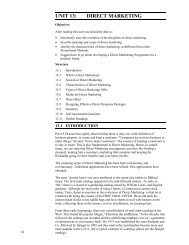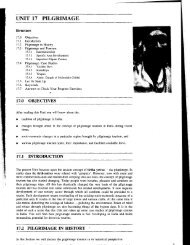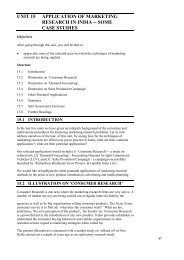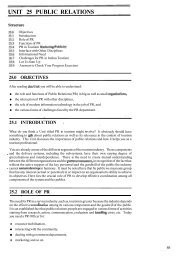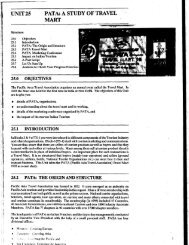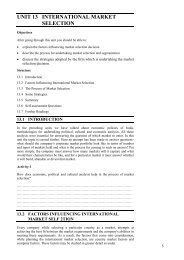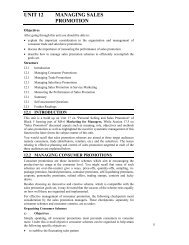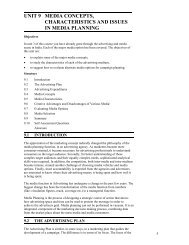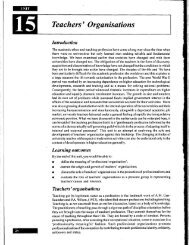UNIT 4 TOURISM AND CULTURE : SOME VIEWS - eGyanKosh
UNIT 4 TOURISM AND CULTURE : SOME VIEWS - eGyanKosh
UNIT 4 TOURISM AND CULTURE : SOME VIEWS - eGyanKosh
You also want an ePaper? Increase the reach of your titles
YUMPU automatically turns print PDFs into web optimized ePapers that Google loves.
Culture and Tourism:<br />
particularly during the 19th century. Their traditions andvalues were eroded and their history, Some views<br />
because it was-based on oral tradition and had no written records, was disregarded.<br />
The coming of mass tourism into the country during the 1950s and 1960s further intensified<br />
these trends. The Indian lands were confiscated for building hotels and developing tourist<br />
resorts. All the benefits derived from the tourist influx, however, went into the coffers of the<br />
outsiders who owned hotels and shops. The local people virtually have no control over the<br />
tourism business at any level. The suggestions made by the author in this case are given<br />
below:<br />
"The choice to participate in tourism should be available and where intermediaries are still<br />
desirable, economic benefits must be retained, not just locally, but by the generators<br />
('owners') of ethnic tourism, whether led by craft, performance or other visitor experience.<br />
"As a corollary, tour promotion by national and international operators can ensure greater<br />
pre-tour information and guide- training (especially of indigenous representatives),<br />
consistently throughout the tour-hospitality system.<br />
"The political and economic forces that will require both resistance and change, are<br />
substantial in the case of Mexico. Indigenous populations risk being overridden by economic<br />
imperatives and resource-exploitation, including mass and invasive tourism. The adaptation<br />
and survival of the Indian socio-cultures to date is all the more remarkable for this, and<br />
therefore tourism must learn from and mitigate these effects, and render meeting grounds<br />
places of mutual respect and experience."<br />
4.2.5 Summing Up<br />
In the foregoing account we have basically analysed four situations brought about by the<br />
interaction of the tourists with the local population.<br />
i)<br />
In case of Spain, faced with the tourist onslaught on their most cherished and popular<br />
festival, the Alarde, the people of Fuenterrabia withdrew and the festival lost its charm<br />
and meaning and became a purely staged event for the purpose of tourism.<br />
ii) In Indonesia, two tourist sites have been discussed. In the case of Toraja, we find that<br />
although the local people made and still make efforts to save their culture, they have, in<br />
effect, been completely swamped by the tourist invasion. They have defmitely derived<br />
economic benefits and socio- recognition; but they are very much in danger of<br />
losing their cultural identity and traditions.<br />
In Bali, however, the local culture has proved more resilient. It has saved itself by the<br />
process of "cultural involution" which has reinforced the tradition just because that is<br />
what the tourists like. Moreover, the Balinese people distinguish between the demands<br />
of the tourists and those of their gods and have institutionalised this separation by making<br />
different objects for the tourists (which may involve making of some compromises in their<br />
traditional arts and crafts) from what they make for their ritual offerings.<br />
iii) In the case of a village in Greece we see that the lure of money has been so overpowering<br />
that the local population is willingto compromise on all aspects of their culture and<br />
values. However, they have been the beneficiary of the economic boom brought about<br />
by tourism.<br />
k<br />
iv) The red Indians of Mexico have benefitted neither economically nor culturally by the<br />
tourist encounter. They have been the losers on all counts. In their case, it is a<br />
phenomenon of internal and external colonialism ushered in by the state-sponsored<br />
tourism. Their example can be true of many oppressed and marginalised communities<br />
in the third world countries.






